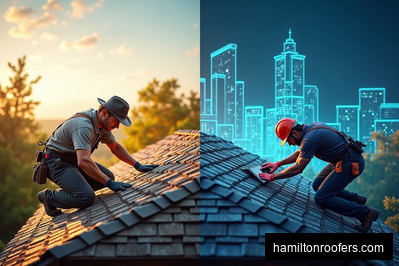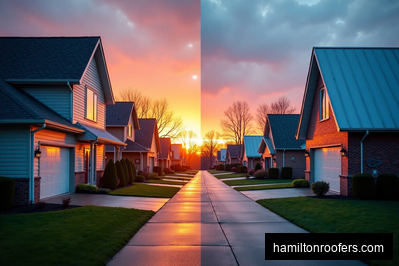Introduction
The roofing techniques we employ today are the result of centuries of innovation, trial and error, and the relentless pursuit of better, more efficient ways to shelter our homes. From simple thatched roofs to today's high-tech, energy-efficient designs, the evolution of roofing techniques is a fascinating journey through human ingenuity and resilience. This article will provide an in-depth look at that journey, highlighting the major milestones and changes that have occurred throughout history.
In delving deeper into the realm of roofing history, we uncover a rich tapestry of ancient civilizations and their innovative approaches to shelter and protection. From the terracotta tiles of ancient Rome to the intricately thatched roofs of traditional Japanese architecture, each culture brought its unique perspective to the evolution of roofing techniques. The Introduction section merely scratches the surface of this fascinating journey through time, highlighting the intricate interplay between environmental factors, cultural practices, and technological advancements that have shaped the roofs we see today.
Traditional Roofing Techniques
Our ancestors utilized materials easily available in their environment to create roofs for their dwellings. The simplest and oldest form of roofing is the thatched roof, made from plant stalks, reeds, or straw. Examples include the cottages of England and Ireland, where weather conditions made these materials plentiful. Thatched roofs are surprisingly durable, with some lasting up to 60 years. However, they carry a high risk of fire.
In regions with abundant timber, such as North America, wooden shingles were common. These provided excellent insulation but required regular maintenance to prevent rot and insect damage. In arid regions like the Middle East, flat roofs made from mud or clay were popular, doubling as living spaces due to the cooler temperatures they provided.
In addition to utilizing natural materials, traditional roofing techniques often involved intricate craftsmanship that has stood the test of time. For example, thatched roofs, a hallmark of traditional roofing in many cultures, required a skilled hand to tightly weave together straw or reeds to create a durable and weather-resistant covering. These techniques not only provided functional shelter but also showcased the artistry and ingenuity of our ancestors in creating sustainable and aesthetically pleasing roofs.
Transition to Modern Roofing
The Industrial Revolution in the late 18th century brought about significant changes in roofing materials and techniques. The mass production of clay tiles and slates, coupled with improved transportation, made these materials more accessible and affordable. Slate, in particular, became a popular roofing material due to its durability and fire resistance, as evidenced by the many Victorian and Edwardian buildings in the UK and US that still retain their original slate roofs.
The late 19th and early 20th centuries saw the introduction of metal roofing, initially used mainly for industrial and commercial buildings due to its durability and fire resistance. Corrugated iron, in particular, was widely used in Australia and New Zealand, where it was known as 'Ironclad'. The iconic red barns of rural America were also traditionally roofed with corrugated iron.
As we delve deeper into the transition to modern roofing, it's fascinating to see how sustainability has become a core focus. Green roofs, for instance, adorned with vegetation, not only enhance building aesthetics but also contribute to energy efficiency and stormwater management. Additionally, advancements in materials like solar tiles and cool roofs are revolutionizing the industry by offering innovative solutions that blend functionality with eco-consciousness.
Modern Roofing Techniques
Today's roofing techniques are characterized by diversity, with a wide range of materials and styles to choose from. Asphalt shingles, introduced in the early 20th century, are the most popular roofing material in North America due to their affordability and ease of installation. Modern versions often include fiberglass reinforcement for increased durability.
Metal roofing has also evolved, with materials like copper, zinc, and stainless steel offering high durability and a distinctive aesthetic. Meanwhile, clay and concrete tiles remain popular in Mediterranean and Southwestern US architecture, valued for their longevity and thermal properties. More recently, synthetic roofing materials, such as rubber, plastic, and synthetic slate, have become available, offering the aesthetic of traditional materials with improved durability and lower maintenance requirements.
One notable advancement in modern roofing techniques is the increased focus on sustainability. Many homeowners are opting for eco-friendly roofing materials such as solar panels or green roofs, which not only reduce energy costs but also contribute to a greener environment. Additionally, innovations in roofing technology have led to the development of cool roofs, designed to reflect more sunlight and absorb less heat, ultimately lowering cooling expenses for homeowners.
The Future of Roofing
The future of roofing lies in sustainable and energy-efficient designs. Green roofs, which incorporate vegetation on the rooftop, can improve insulation, reduce urban heat island effects, and promote biodiversity. Solar roofs, like those developed by Tesla, incorporate solar panels directly into the roof tiles, providing a seamless way to generate electricity. Cool roofs, coated with reflective materials to reduce heat absorption, are another solution for reducing energy use and combating climate change.
As we look to the future, the evolution of roofing techniques will undoubtedly continue, driven by technological advancements and the need to create sustainable, resilient buildings. Regardless of the changes that lie ahead, the core purpose of a roof - to provide shelter and protection - remains unchanged, a testament to the enduring importance of this fundamental architectural element.
Innovations in roofing technology are shaping the future of the industry towards sustainability and efficiency. Advancements like solar roof tiles that seamlessly blend renewable energy generation with traditional roofing materials are gaining momentum. Additionally, the integration of smart roofing systems equipped with sensors and Io T capabilities is revolutionizing maintenance practices by enabling proactive monitoring and predictive maintenance. These developments not only enhance the functionality of roofs but also contribute towards a greener and more resilient built environment.
Conclusion
The evolution of roofing techniques reflects our continuous quest for better, more efficient ways to protect our homes. From humble beginnings using plant stalks and clay, we have developed an array of materials and methods that cater to diverse climatic conditions, architectural styles, and personal preferences. As we move forward, the emphasis on sustainability and energy efficiency will continue to shape the direction of this fascinating journey.
In the end, the best roofing technique is the one that meets your specific needs, considering factors such as climate, budget, aesthetic preference, and long-term durability. By understanding the evolution of roofing techniques, you can make a more informed decision when it comes time to choose a roof for your own home.
In conclusion, the advancements in roofing techniques not only showcase our dedication to innovation but also underscore the importance of sustainability in construction practices. By embracing eco-friendly materials like solar panels or green roofs, we can reduce our carbon footprint while enhancing the functionality of our roofs. Furthermore, the integration of smart technologies such as weather sensors or energy-efficient insulation systems in modern roofing solutions exemplifies our commitment to creating more energy-efficient and resilient buildings for the future.









